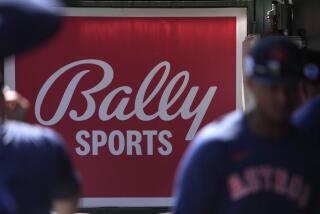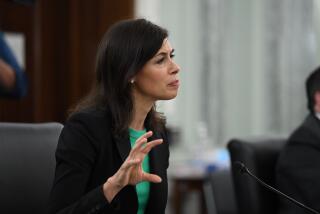FCC Gives Approval to Digital TV License Plan
- Share via
WASHINGTON — Federal regulators on Thursday gave formal approval to a plan awarding new licenses to owners of the nation’s television stations so they can bring razor-sharp images, CD-quality sound and an array of new services to American viewers beginning in December 1998.
The decision by the Federal Communications Commission clears the way for the most important innovation in U.S. broadcasting since the introduction of color TV in the late 1950s.
But it also sets the stage for an epic battle between traditional TV set manufacturers like Sony Corp. and Zenith Electronics Corp. and the computer industry for dominance of the huge consumer electronics marketplace.
It also raises questions over whether the broadcasters are receiving what the public-interest group Common Cause calls a “$70-billion corporate welfare bonanza.”
And it means that many of the owners of the nation’s 280 million TV sets will have to scrap those in favor of more costly digital televisions or buy special converters to receive the new signals.
Digital TV sets are expected to cost from $2,000 to $5,000 when they first appear on the market. Although their prices will probably drop sharply, they are likely to remain hundreds of dollars more costly than today’s conventional analog sets. Converter boxes may cost only $100 per set, however.
The most immediate effect of the FCC decision is to hold the major broadcast networks to an earlier pledge to launch digital service at 23 of their owned-and-operated stations in the top 10 markets--including Los Angeles, the second-largest--within 18 months. The rest of the network-owned stations in those markets must go digital within 24 months.
FCC Chairman Reed Hundt said Thursday that by Christmas 1999, about 53% of U.S. households will be receiving at least three digital stations.
Digital television evolved out of a 10-year effort by the U.S. to surpass the Japanese in creating the next generation of television technology. Because the digital signal can be electronically compressed, allowing more data to be transmitted along the comparable bandwidth of the radio spectrum, broadcasters will be able to fit three to five channels on airwaves that now accommodate only one.
The digital signal can also provide distortion-free pictures and sound rivaling movies shown in theaters, as well as data such as that transmitted today among computers wired to the Internet. That capability would allow broadcasters of sporting events, for example, to deliver a stream of team or player statistics for viewers to call up during a contest.
One question is whether broadcasters will use the greater capacity to create a vaster wasteland. Hundt, for one, has publicly called for imposing higher public-service standards on digital broadcasters, including, for example, a requirement that they provide free air time to candidates for political office.
As for technical and financial issues, broadcasters say that some equipment needed for digital broadcasting has not yet even been designed. Conversion to digital format could cost $1 million to $3 million per station, according to Harris Corp., the leading manufacturer of digital equipment.
*
The logistics of converting to digital technology could pose an immense problem for some broadcasters, said Bob Weirather, director of TV products for Harris’ broadcast division. In congested and contentious areas like New York City, he said, the logistics for overhauling transmission are so troublesome that broadcasters may have to shut down their analog signals for part of the day to install new digital towers.
“It’s likely that there will be some delay in some places” in the changeover in equipment, he said.
For all that, the FCC’s decision to give away the digital licenses rather than placing them up for auction is highly controversial because FCC officials have estimated that an auction could bring from $20 billion to $70 billion in bids.
The giveaway was opposed by Hundt, Sen. John McCain (R-Ariz.), chairman of a subcommittee overseeing the telecommunications industry, and such public-interest groups as Common Cause. They observed, among other things, that the FCC rules require broadcasters to provide at least one free digital channel over the air but allows them to use the rest of their expanded channel capacity for other fee-based services, such as subscription TV and data services.
Supporters of the giveaway argue that it is necessary to subsidize the cost of analog-to-digital conversion and to preserve today’s system of free, advertiser-supported over-the-air TV.
“I do not agree with those who say this is a free giveaway to broadcasters,” said Commissioner Rachelle Chong. “This is a technology transfer. You just can’t shut off analog TV” and start digital broadcasting.
Edward O. Fritts, president of the National Assn. of Broadcasters, said station owners are eager to roll out digital TV on schedule and would likely concentrate on providing digital broadcast services rather than ancillary offerings like pay-TV and data services.
“We are marching down the digital road now and the American consumer will be the big beneficiary,” Fritts said.
Over the next nine years, broadcasters will be required to return their current analog TV channels to the federal government. Of that 138 megahertz spectrum, 36 megahertz would be given to police or fire departments for public safety use and the rest would be auctioned to a variety of users, including low-power conventional TV stations.
One other burning question is which hardware industry will be the ultimate beneficiary of the new technology. As early as next month, executives of software giant Microsoft Corp., Compaq Computer Co. and chip maker Intel Corp. will go before broadcasters meeting in Las Vegas to lay out their visions of how television and personal computer technologies will converge--presumably via the computer monitor.
Shiver reported from Washington and Hiltzik from Los Angeles.
More to Read
The biggest entertainment stories
Get our big stories about Hollywood, film, television, music, arts, culture and more right in your inbox as soon as they publish.
You may occasionally receive promotional content from the Los Angeles Times.










